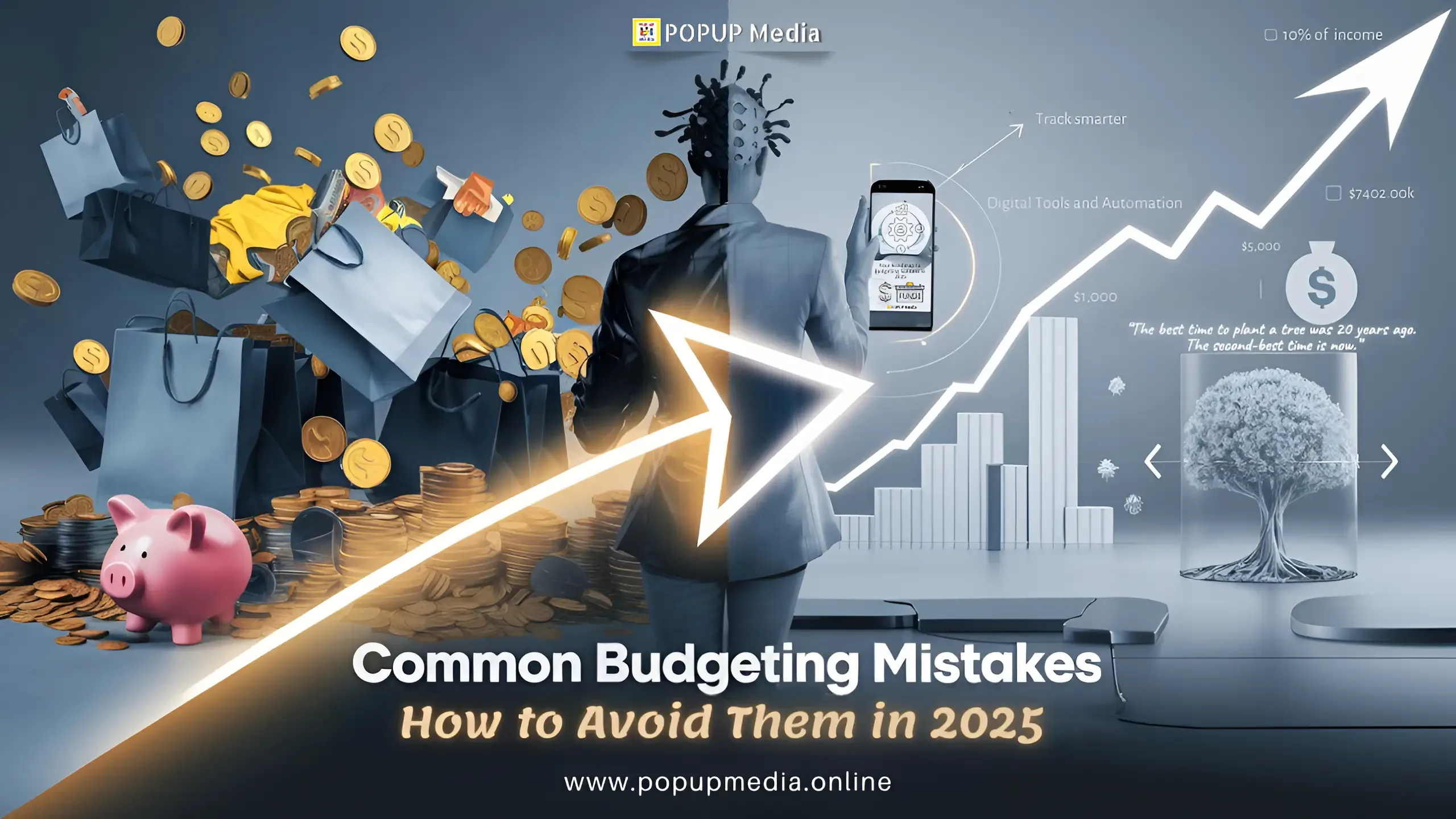Why Budgeting in 2025 Demands Smarter Strategies
Let’s be honest: Budgeting isn’t exactly a thrill ride. But in 2025, getting your finances right isn’t just about saving pennies—it’s about surviving in a world where inflation, tech advancements, and economic shifts are reshaping how we manage money. You’ve probably tried budgeting before, only to fall off track by February. Sound familiar?
This year, 59% of Americans live paycheck to paycheck (Source: LendingClub), and with rising costs of housing, healthcare, and education, old budgeting habits won’t cut it. The good news? Avoiding common pitfalls can transform your financial future. Let’s dive into the top budgeting mistakes people make in 2025 and how you can sidestep them like a pro.
Table of Contents
- Mistake #1: Not Tracking Every Dollar
- Mistake #2: Underestimating Emergencies
- Mistake #3: Ignoring Inflation
- Mistake #4: Lifestyle Creep
- Mistake #5: Unrealistic Targets
- Mistake #6: Avoiding Digital Tools
- Mistake #7: Ignoring Life Changes
- Mistake #8: Mismanaging Debt
- Mistake #9: Skipping Budget Reviews
- Mistake #10: Neglecting Long-Term Savings
Mistake #1: Not Tracking Every Dollar (Yes, Every Dollar)
The Problem:
Why It Happens:
Tracking manually feels tedious, and many apps only categorize broad
spending.
How to Avoid It
- Use AI-Powered Budgeting Apps: Tools like Rocket Money or YNAB automatically track every transaction and flag overspending.
- The 48-Hour Rule: Wait two days before making non-essential purchases. You’ll be surprised how many “wants” turn into “mehs.”
- Weekly Check-Ins: Spend 10 minutes every Sunday reviewing your spending.
Mistake #2: Underestimating Emergency Expenses
The Problem:
Why It Happens:
We’re optimistic creatures. We think, “It won’t happen to me”—until it
does.
How to Avoid It
- Build a “Layered” Emergency Fund:
- Layer 1: $1,000 for immediate crises (start here).
- Layer 2: 3–6 months of living expenses.
- Layer 3: “Insurance” for specific risks (e.g., pet insurance).
-
Automate Savings: Set up automatic transfers to a high-yield savings account.
Mistake #3: Ignoring Inflation’s Sneaky Impact
The Problem:
Why It Happens:
People assume last year’s budget will work this year.
How to Avoid It
- Adjust Your Budget Quarterly: Increase categories like groceries and gas by 3–5% annually.
- Invest in Inflation-Proof Assets: Consider Treasury Inflation-Protected Securities (TIPS) or stocks in sectors like energy.
📊 Table: U.S. Inflation Rates Comparision
| Year | Inflation Rate |
|---|---|
| 2020 | 1.2% |
| 2021 | 4.7% |
| 2022 | 8.0% |
| 2023 | 4.1% |
| 2024 | 3.5% |
| 2025* | 2.9% (Projected) |
Projected [Source: U.S. Bureau of Labor Statistics - (BLS)]
"Before upgrading your tech or splurging on trends, ask: Is this aligned with my priorities? See how 2025’s digital marketing tactics exploit FOMO—and how to resist them."
Mistake #4: Letting Lifestyle Creep Derail Your Goals
The Problem:
Why It Happens:
We equate earning more with spending more.
How to Avoid It
-
Follow the 50/30/20 Rule:
- 50% on needs
- 30% on wants
- 20% on savings/debt
-
Freeze Non-Essential Spending for 30 Days after a pay raise.
Mistake #5: Setting Unrealistic Financial Targets
The Problem:
Why It Happens:
We overestimate short-term willpower and underestimate long-term
challenges.
How to Avoid It
-
Use the SMART Framework:
- Specific: “Save $5,000 for a down payment” instead of “Save more.”
- Measurable: Track progress monthly.
- Achievable: Start small (e.g., save 10% of income, not 50%).
- Relevant: Align goals with your values (e.g., travel vs. a new car).
- Time-Bound: Set deadlines (e.g., “Pay off $5K debt in 12 months”).
-
Break Goals into Milestones: Celebrate saving 500 before aiming of 5000.
📈 Example of a SMART Goal Table:
| Goal Type | Bad Example | SMART Example |
|---|---|---|
| Debt Repayment | “Pay off debt faster” | “Pay $300/month toward credit cards for 18 months” |
| Savings | “Save for emergencies” | “Build a $3K emergency fund in 10 months” |
Mistake #6: Overlooking Digital Tools and Automation
The Problem:
Why It Happens:
Fear of complexity or distrusting technology.
How to Avoid It
- Adopt Automation Tools:
-
Sync All Accounts: Link bank, credit, and investment accounts for a 360° financial view.
"Tools like AI-powered budgeting apps are just the beginning. Want to future-proof your finances? Discover how crypto wallets, AI advisors, and metaverse economies will reshape money management in 2025."
Mistake #7: Forgetting to Adjust for Life Changes
The Problem:
Why It Happens:
We treat budgets as “set it and forget it” plans.
How to Avoid It
-
Conduct a “Life Audit” Every 6 Months: Ask:
- Have my income or expenses changed?
- Are my goals still relevant?
- Build Flexibility into Categories: Allocate 5–10% of your budget to “adjustment funds” for surprises.
- Plan for Known Changes: Expecting a baby? Start a “childcare” category 9 months in advance.
Mistake #8: Mismanaging Debt Repayment Strategies
The Problem:
Why It Happens:
Debt fatigue—it’s easier to focus on quick wins than long-term math.
How to Avoid It
-
Use the Avalanche or Snowball Method:
- Avalanche: Pay off highest-interest debt first (saves more money).
- Snowball: Pay off smallest balances first (builds momentum).
- Refinance Strategically: Consolidate credit card debt into a low-interest personal loan.
- Avoid New Debt: Freeze credit cards physically (literally—put them in a block of ice!).
💡 Debt Repayment Comparison Table:
| Method | Best For | Pros | Cons |
|---|---|---|---|
| Avalanche | Math-driven savers | Saves interest | Slow progress |
| Snowball | Motivation seekers | Quick wins | Costs more long-term |
Mistake #9: Skipping Regular Budget Reviews
The Problem:
Why It Happens:
Life gets busy, and reviewing finances feels like a chore.
How to Avoid It
-
Schedule Weekly 15-Minute Money Dates: Use this
time to:
- Track spending.
- Adjust categories (e.g., overspent on dining out? Reduce next week’s limit).
- Monthly Deep Dives: Analyze net worth, debt progress, and savings rates.
- Use Visual Trackers: A debt-free thermometer or savings milestone chart keeps you motivated.
Mistake #10: Not Prioritizing Long-Term Savings
Why It Happens:
Long-term goals feel distant, and instant gratification is tempting.
How to Avoid It
- Pay Yourself First: Automate transfers to retirement accounts (e.g., 401(k), Roth IRA).
- Leverage Compound Interest: Start investing early—even 200/month at 7200/month at 7402K in 30 years.
- Diversify Savings Buckets:
- Retirement: 15% of income.
- Education: 529 plans for kids.
- Wealth Building: Low-cost index funds.
“The best time to plant a tree was 20 years ago. The second-best time is now.” — Chinese Proverb (applies perfectly to retirement savings!).
Key Takeaways: Your Roadmap to Budgeting Success in 2025
- Be Realistic: Use SMART goals to avoid burnout.
- Embrace Tech: Automate tracking, bills, and savings.
- Stay Flexible: Adjust for life changes and inflation.
- Tackle Debt Wisely: Choose avalanche or snowball methods.
- Think Long-Term: Prioritize retirement and compound growth.
FAQs: Answers to Your Burning Budgeting Questions
1. Which debt repayment method is better—avalanche or snowball?
2.How much should I save for retirement in 2025?
3. Can I use multiple budgeting apps at once?
4. What if my income fluctuates monthly?
5. How do I stay motivated to review my budget?
References
- LendingClub (2023) - Paycheck-to-Paycheck Report
- U.S. Bureau of Labor Statistics, Inflation Data
- NerdWallet, “2024 Consumer Finance Report”
- Forbes, “Budgeting Habits Post-Pandemic,” 2024
- Federal Reserve, “Consumer Debt Trends,” 2024
Final Conclusion: Your Path to Financial Confidence in 2025
Budgeting in 2025 isn’t just about spreadsheets and sacrifice—it’s about strategic empowerment. The financial landscape is evolving faster than ever, with inflation nudging prices upward, digital tools reshaping money management, and life’s unpredictability demanding flexibility. But as you’ve seen, avoiding common mistakes doesn’t require perfection—just proactive habits and a willingness to adapt.
"Budgeting smarter isn’t just about spreadsheets—it’s about balance. Boost your focus (and sanity) with 2025’s essential digital well-being hacks."
You now have the tools to:
- Track smarter, not harder, using AI-powered apps to catch sneaky microtransactions.
- Prepare for the unexpected with a layered emergency fund that shields you from life’s curveballs.
- Outsmart inflation by adjusting your budget quarterly and investing in resilient assets.
- Crush debt strategically, whether you’re team Avalanche or Snowball.
- Future-proof your savings, letting compound interest quietly build your retirement nest egg.
Remember, financial success in 2025 isn’t about drastic overhauls. It’s about small, consistent wins—celebrating that $500 milestone, automating a 10% savings rate, or resisting lifestyle creep after a raise. As the Chinese proverb reminds us:
“The best time to plant a tree was 20 years ago. The second-best time is now.”
Your budget is more than numbers—it’s the blueprint for the life you want. Whether that’s debt freedom, a dream vacation, or retiring early, 2025 is your year to take control. Start today, stay adaptable, and watch those smart choices compound into lasting financial freedom. 💸
Ready to thrive? Your future self is already cheering you on. 🚀
“Recommended Reads”
🚀 Dive Deeper into 2025’s Financial Trends:





